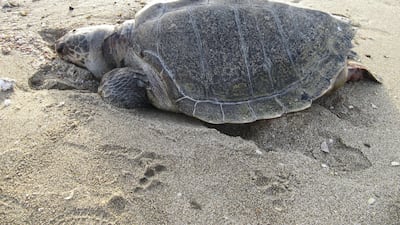Jibran Al Ismaili did not know he was breaking the law until the police came knocking on his door in July and took away the 52 baby sea turtles he was keeping in a pool at his home in Muscat.
The 44-year old university lecturer said he got the turtles from the beach at Ras Al Hadd in the eastern region of the country. He was not arrested, but he was made to sign a warning letter that he would not repeat the offence.
"I camp with friends at Ras Al Hadd on some weekends and I pick up a few of these cute little turtles and take them home. I did not know that I was breaking the law until a few months ago, when I got the knock on the door," Mr Ismaili told The National.
"I am sure one of my neighbours alerted the police because they have a good view of my pool in the back garden.”
All four species of sea turtles that nest in Oman are listed as endangered by the environment ministry. Keeping them as pets or taking them out of the country is forbidden, but this has not deterred animal smugglers who visit the country as tourists and attempt to smuggle out thousands of turtles each year.
Since there is no provision under the law to punish offenders, they are released after the animals are taken from them. The turtles are returned to sea. The government is currently considering a penalty of up to two months in prison and/or a fine of $5000 (Dh18,365).
There are no statistics available for this year, but in 2016 the police detained 124 visitors who were attempting to smuggle out nearly 3,200 baby turtles, according to the environment ministry. Offenders are mainly from Far Eastern countries, East Europe and North Africa.
The same figures also show an increase of 11.6 per cent on the number of people arrested in 2015 for what environmentalists call “baby turtles snatching”.
“It is an organised crime with these so-called tourists coming here to Oman to snatch baby turtles from their nesting grounds. There is a big market outside Oman for turtle farming. Most of these turtles found in Oman, such as the hawksbills, are rare and they are in demand. You find them in very few countries around the world,” said Dr Ghulam Al Balushi, member of Environmental Society of Oman (ESO).
“The government needs to decide quickly on the punishment level of offenders. These turtle snatchers find a loophole in the law and take advantage. A stiff prison sentence and thousands of dollars of fine is a good start,” Dr Al Balushi added.
According to ESO, four species of marine turtles, the loggerhead, greenback, hawksbill and Olive Ridley, breed on the beaches of Ras Al Hadd and Masirah island. Oman has the highest loggerhead turtle population in the world, and Dr Balushi estimates that about 50,000 of all varieties nest each year on Omani beaches. Since these species have different nesting seasons, the turtle nesting season is spread out over most of the year.
To protect them, the government has established a monitoring and conservation programme at the nesting grounds to keep track of these rare species. In co-ordination with rangers and leading universities of the world, such as Swansea University, local authorities have also undertaken the task of tagging turtles and collecting data for record keeping. However, the monitoring system is not working with poachers.
“The monitoring system is working to see how and where they nest and swim. The tag is attached to an adult turtle. Poachers get the babies. We know how many are hatched each year here in Oman but how many of them get poached is very difficult to know,” Dr Al Balushi said.
The environment ministry says that over 15,000 eggs hatch every year. However, according to Dr Balushi, "it is very difficult to know how many turtles actually survive after hatching because some of them get eaten by birds on their way to the sea".
Wan Wong, a Chinese citizen living in Oman, said China is a big market for sea turtle farming and baby turtles are in demand.
"I know some of my compatriots come to Oman to poach turtle babies. It is a big business back home. The little ones are bred and nurtured to adulthood and they end up in a soup. It is a Chinese delicacy that is served in most restaurants in China. Also, turtle babies are sold as pets," said Mr Wong, who works at the China Dragon Mall in Barka, in the Al Batnah Region, told The National.
A baby turtle can cost anywhere between $20 and $30 in China, but rare species can go up to $300, according to Mr Wong.
Turtle watching attracts about 650,000 visitors to Oman every year, according to the tourism ministry. Besides Masirah Island and Ras Al Hadd, the Daymaniyat island cluster is another popular place for watching turtles nest and hatch. The government decided in 2010 to employ rangers to protect these sites from poachers, but the move has not been entirely effective.
“By my estimate, we catch half the culprits and the other half get away with it. It is a hard job monitoring it. We have a vast coastline and there are not enough of us to do the job effectively. I guess it is not practical to employ a large number of rangers, because it is not economical,” said Waleed Al Omar, one of the rangers at Ras Al Hadd.
Oman has the longest coastline in the region, stretching 1,700km from the UAE in the north to Yemen in the south, where as the number of rangers employed to protect turtle nesting sites is just over 150.

